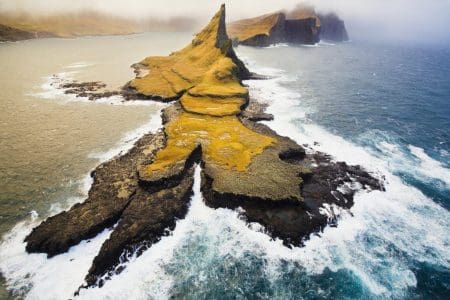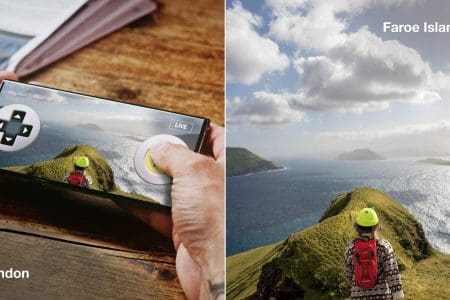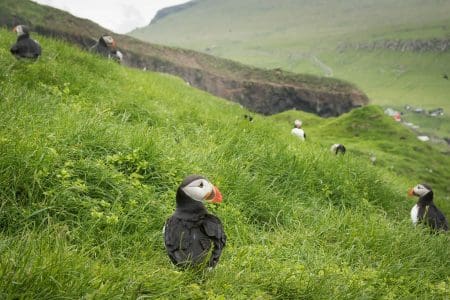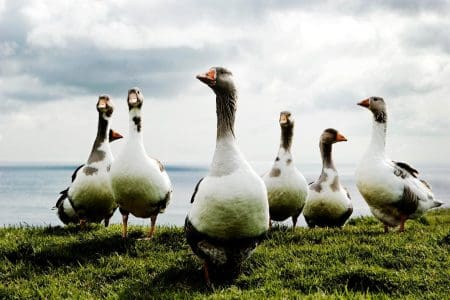An archipelago of 18 islands scattered over some 274,000 sq km in the Atlantic, about halfway between Scotland and Iceland, the Faroes are about as remote as you can get in the modern, globalised world of travel. But this is part of their charm.
Ever since a group of Irish monks landed here in the 6th Century, the Faroe islands have been known for their sheep and birdlife – as well as the quite brutal weather. If getting away from it all and becoming one with nature is your idea of a holiday, while enjoying the most amazing scenery and travelling back in time, then Faroe Islands travel is for you.
With a long history, rich culture, vibrant festivals and emerging cuisine, the islands of sheep might just surprise you.
One thing is for sure, with a population of just over 50,000, spread over 1,399 sq km of land, and with almost half of that in the capital Tórshavn, there is plenty of space in which to lose yourself. Nowhere on the mountainous islands is more than five kilometres from the ocean, so you are virtually assured of breath-taking sea views. Despite the strong winds, the islands have their own micro-climates; while you might be bedecked in cloud, somewhere else in the islands there may well be sun, often at the end of a rainbow.
At the end of your Faroe Islands holidays you might just find yourself longing to come back for more.
Read on for more guidance on Faroe Islands travel for the Over 40s, or click here for a short video.
Faroe Islands Heritage and Culture
The Faroe Islands were first settled in the 6th Century when Irish monks landed on the group of 18 islands. However, it was not until the Vikings came from Norway some 300 years later that the Faroe Islands were called Føroyar from the old Norse for “Sheep Islands”.
The Vikings established their own parliament or Althing, later called Løgting, at Tinganes in Tórshavn in 825 AD, on the site where the modern day parliament still stands, making it arguably the oldest parliament in the world (see below).
Eventually, the Faroes became part of Norway in the 12th Century, and later still they were assimilated into the dual monarchy that included Denmark. In 1814, the islands became the sole sovereignty of Denmark, although they preserved their own jurisdiction, language and culture, guarded by the Løgting.
In 1948, the Home Rule Agreement gave the islanders extensive powers for self-government. Despite moves for independence the islands still remain part of Denmark (see below).
In addition to Tórshavn, the historic centre of Kirkjubøur, is well worth a visit. St Magnus Cathedral, or Múrurin, was built around 1150 and abandoned 400 years later, but its ruins remain. The 13th century St Olaf’s, or St Mary’s, Church is now restored, as is a building that was part of the bishop’s palace. The latter is now a museum, providing a sense of how people used to live here.
With a quirky rhythm the ballads of the islands’ heroes can stretch for hundreds of verses
On your Faroe Islands travel you will discover that traditional arts and culture are still flourishing. The islands’ isolation has allowed a distinct culture to develop, although one deeply rooted in Norse traditions. As the Faroese language was not established until 1854, and only recognised by the Danes in 1938, the spoken word and folk song have always played an important part in the local culture, with stories and myths handed down between generations orally.
One distinctly Faroes cultural tradition is the Chain Dance, which was originally a mediaeval ring dance. With a quirky rhythm the ballads of the islands’ heroes can stretch for hundreds of verses. The dance captain leads the singing with the assembled throng joining in the chorus. The dance is supposed to unite people from different social backgrounds in one full circle or chain, and albeit temporarily sharing some common ground.
The largest live music venue on the islands is the Nordic House in the capital Tórshavn. Alternatively, there is Fuglafjørður cultural house, or the Reinsaríið, a restored old building in the heart of Tórshavn, which hosts a number of live music events. Jazz lovers should head to Blabar, also in the capital, where there are live music performances, not just jazz, most nights.
Cousins William Heinesen and Jørgen-Frantz Jacobsen are the island’s most famous literary sons. Heinesen’s former house has been converted into an excellent restaurant, Katrina Christiansen, with many of his original ornaments and furniture preserved, including his writing desk.
However, if you really want to get a feel for what life used to be like on the island as well as a great read for your Faroe Islands travel, pick up Jacobsen’s novel Barbara in the book shop in Tórshavn, the heroine of which bears more than a passing resemblance to Hedda Gabbler.
Did You Know?
The Faroese Veðrur or coat of arms consists of a blue shield with a ram, a motive that dates back to the Middle Ages. The oyster catcher, or tjaldur, is the Faroese national bird and the buttercup (sólja) is the national flower.
Latest Faroe Islands Posts
From our travel news, articles, events, and offers.
Outdoors and Nature in the Faroe Islands
The Faroe Islands erupted out of the Atlantic Ocean some 50 to 60 million years ago due to volcanic activity. The consequent plateau was then moulded during the Ice Age into a series of mountains, valleys and fjords.
Rugged and rocky, the islands consist of a series of steep mountains with Slættaratindur the highest peak, rising 882 metres above the sea. The coastline is mostly cliffy, offering excellent nesting for the flocks of seabirds that nest here.
Discovering what to do in the Faroe Islands is a delight; pick up a Faroe Islands map, jump in you car, or on your bike or simply put on your hiking boots, and you will be struck by the green-clad cliffs rising out of the waters with hundreds of waterfalls cascading down them.
The most scenic routes are handily marked as buttercup routes on Faroe Islands maps dispensed at the airport and tourist places. One of these takes you up to the village of Tjønuvik at the north of the main island of Streymoy. Along the way you pass the Fossá waterfalls, the largest in the Faroe Islands, before stopping at Tjønuvik with its views towards the Giant and the Witch; twin rocks legend says will drag the islands back to Iceland.
The views here are quite spectacular, making it quite impossible not to stop and take photos as the omnipresent sheep munch away on the grass
Another great route takes you across Streymin bridge – the only bridge across the Atlantic Ocean in the world – to Eysturoy island and up to Gjógy. The views here are quite spectacular, making it quite impossible not to stop and take photos as the omnipresent sheep munch away on the grass.
Although the Faroes are named after sheep, there are relatively few land animals on the islands, reflecting their remoteness. There are, however, plenty of seabirds and marine life that you can see either while rambling or by boat.
One such trip recommended on your Faroe Islands travel, weather permitting from May to September, is to the magnificent 1,500-feet high Vestmanna bird cliffs, where you can see a variety of sea birds, including puffins.
Alternatively, you can take the ferry to Nólsoy, a 20-minute ride from Tórshavn, and from there walk around the island and see puffins as well as the European storm-petrel if you are wandering out at night, before listening to music at Maggie’s Bar, which stays open to 4am at weekends.
If the Faroe Islands weather permits, you can also take the Mykines, the most westerly of the Faroe Islands, which is an important bird nesting sight especially for puffins, gannets and shags.
Mykineshólmur Lighthouse is the most westerly of the Faroe Islands lighthouses, although the Borðan and Nolsoy Lighthouses on Nólsoy and the Skansin Fort Lighthouse in Streymoy in the capital Tórshavn are more accessible.
Who owns the Faroe Islands?
The Faroe Islands is a self-governing region in Denmark with its own flag, language and Parliament; it is not part of the European Union.
During World War II, it was occupied by the British, but following liberation – the last British troops left in September 1945 – a majority voted for independence from Denmark in 1946. However, the Danish Parliament refused to accept this vote, and instead the Act of Faroese Home Rule was passed in 1948.
A referendum scheduled for 2001 on initial steps towards independence was cancelled after Danish PM, Poul Nyrup Rasmussen, said that Danish grants would be phased out within four years of a ‘yes’ vote.
Faroese Gastronomy
Perhaps more than most countries, food in the Faroe Islands reflects its culture and the limitations placed upon the inhabitants by both climate and landscape.
The harshness of life on the islands taught the Faroese to make good use of all food caught or raised, as well as storing food through the winter. Traditionally the islanders ate fish, pilot whales (see below), birds and sheep.
Meat and fish were aged and fermented outdoors to preserve them, creating a specific flavour the islanders call ræst, which is an acquired taste, perhaps not best suited for your Faroe Islands holidays.
Faroese cuisine received international recognition when KOKS became the first restaurant on the islands to gain a Michelin star
However, with the advent of refrigeration, Faroese cuisine has adapted and flourished. New restaurants have opened, especially in the capital Tórshavn, disproving the theory that Faroese cuisine was unsuitable for haute cuisine.
In 2017, Faroese cuisine received international recognition when KOKS became the first restaurant on the islands to gain a Michelin star. Now, the restaurant, which specialises in local produce, has just been awarded its second Michelin star. In 2019, KOKS was ranked the second best in Denmark, Greenland and the Faroe Islands by the White Guide Denmark, as well as the best for fish and seafood. Its chef Poul Andrias Zisca also received the 2019 young chef award from the Michelin Nordic Guide.
Five other Faroese restaurants including Ræst, which specialises in fermented Faroese dishes, Áarstova, Barbara Fish House and Fútastova, were also included on the list, highlighting the emergence of the islands, and particularly Tórshavn, as a gastronomic capital.
Fortunately, McDonalds has yet to penetrate the Faroe Islands.
Tórshavn, Capital of the Faroe Islands
The capital of the Faroe Islands, Tórshavn is named after Thor, the Norse god of thunder. Literally translated as Thor’s harbour, Tórshavn is situated on the southeast coast of Streymoy, the largest of the 18 islands. With approximately 20,000 residents, Tórshavn is one of the smallest capitals in the world, almost inevitably you will visit here during your Faroe Islands holidays.
Covering a small peninsula in the centre of Tórshavn, the wonderfully-preserved Reyni is the capital’s historic heart. Here picturesque, emerald-turfed houses have been converted into some of the finest restaurants in the Danish kingdom. There are also museums, galleries, music venues, hotels and cafés.
Many of the black-tarred houses with turfed roofs and bright white windows were built in the 16th and 17th centuries, on narrow streets and lanes, making this a very pleasant stroll, especially if the wind and rain relents.
At the far end of Reyni the red buildings of Tinganes are the seat of government on the islands. This is the area to head to for the cultural things to do on your Faroe Islands travel.
Other buildings of note include: the Nordic House, the most important cultural centre in the Faroe Islands; the Faroese Museum of History (Føroya Fornminnissavn) with artefacts from the Vikings to the Middle Ages; the Museum of Natural History; Tórshavn Cathedral (Havnar Kirkja), the second oldest church in the Faroe Islands; and the National Gallery (Listasavn Føroya).
Around the headland from Tiganes is Fort Skansin, built in 1580 by Magnus Heinason, to protect Tórshavn from marauding pirates. The fort was commandeered by the Royal Navy during the British occupation of the islands in World War II. Two guns used to defend the island still stand here as well as Danish bronze guns from 1782.
In addition to the excellent restaurant scene, Tórshavn also has what nightlife there is on the island with craft ale bar Mikkeller, jazz bar Blabar and the pub Sirkus Föroyar all highly recommended.
Faroe Islands Festivals
Ólavsøka, or Faroese National Day, is celebrated on 29 July to commemorate the death of Norwegian King Olav II in battle on that day in 1030. Olav was key in bringing Christianity to the islands. Parliament opens on this day, as it has for the past 900 years.
Unsurprisingly for a seafaring nation, one of the biggest festivals in the Faroe Islands is the Seafood Festival held in Torshavn at the beginning of May. Free to enter, over 8,000 people attended in 2017. Expect plenty of fresh seafood and performances by Faroese musicians. The event concludes with an evening concert.
Summer sees a flourish of festivals on the Faroe Islands, most noticeably the G! Festival in Syðrugøta , which the Guardian has described as “probably the wildest event on the festival calendar”.
In August, there is the community-friendly Summer Festival at Klaksvík.
Other festivals include the Christian music Fjarðafestivalurin, Sørvágs Country & Blues Festivalur, and the classical and contemporary music festival, Summartónar.
Those in the know could head to possibly the world’s smallest folk music festival, sometimes referred to as the hidden festival as invites are by word of mouth. While the Winter Jazz Days festival is held in January and February.
Faroe Islands Photos
Some of the sights to enjoy on your Faroe Islands travel
All photos used on this Guide to Faroe Islands Holidays are courtesy of Visit Faroe Islands and Mark Bibby Jackson. Main photos taken by Sergio Villalba, Mark Bibby Jackson, Kate Chapman and Barbara Fish House.
Oldest Parliament?
The Vikings established a parliament on the Tinganes peninsula in Tórshavn around 825 AD. This makes it one of, if not, the oldest parliamentary meeting places in the world, alongside the Isle of Man’s Tynwald hill, which is about 1,000 years old, and Þingvellir in Iceland (930 AD).
Faroe Islands Weather
The Faroe Islands are located where the warm Gulf Stream meets the cold streams of the Arctic. This makes the weather changeable and unpredictable, with all four seasons often coinciding in one day. Faroe Islands weather is unpredictable.
Expect plenty of wind and rain and dress accordingly. But don’t despair, while one island might be covered in cloud another might be smothered in sun. Flexibility and patience are key to successful Faroe Islands travel. As they say on the islands, if the weather is not good, wait five minutes.
Perhaps surprisingly, Faroese weather is rather mild, with winters averaging 3C, although summers only average 13C. Summer days are long, with over 19 hours of sunlight, while winter nights are correspondingly lengthy too.
A detailed Faroe Islands weather forecast can be found at yr.no.
The highest temperature recorded on the Faroe Islands was 26C.
Faroe Islands Visa
As the Faroe Islands are part of Denmark, the same rules apply for here as for mainland Denmark. A Faroe Islands visa is not required for citizens of the UK and EU. For further information, visit here.
Many countries get visa on arrival in Faroe Islands. Find out if you need a visa to visit the Faroe Islands here.
Flights to Faroe Islands
The only Faroe Islands airport is in Vagar. Atlantic Airways flies to Vagar Airport from various places across Europe, including Reykjavik, Edinburgh, Copenhagen, Bergen, Barcelona and Lisbon.
Service is excellent and it is possible to buy single tickets thus enabling you to fly from Edinburgh to Vagar and then on to Reykjavik, for example. Direct flights from Paris are due to commence in July 2019 and a New York service is also in the pipeline. SAS also flies to Vagar.
Flying is no the only way to get to Faroe Islands. you can take the ferry from Hirtshals in Jutland, Denmark or from Iceland (summer only). Details of ferries for your Faroe Islands travel can be found here.
Getting Around on Your Faroe Islands Travel
The best and most flexible way to get around on your Faroe Islands travel is to hire a car at the airport. There is also a regular bus service linking the airport with Tórshavn and other places around the island. The more hardy of you could cycle.
Ferries run from Tórshavn to Nólsoy and other places, and there are frequent boat trips.
Public transportation in Tórshavn is free, a measure designed to reduce traffic and CO2 emissions in the capital.
Faroe Islands SIM Cards / Internet
High-speed internet is available throughout the islands, although reception may be patchy in places. Tórshavn buses have free WiFi.
You have two mobile phone providers to choose from for using on your Faroe Islands holidays – ver, which is part of the publically-owned Føroya Tele, and Hey, which is run by Vodafone Faroe.
Føroya Tele prepaid packages can be bought at the tourist information store at Vágar Airport upon arrival on your Faroe Islands holidays, while Hey kits can be purchased at petrol stations. Further information can be found here.
Faroe Islands Whaling
Practised since the first Norse settlers arrived on the Faroe Islands, whaling is an essential part of Faroese life and culture; it seems impossible to walk into a bar without the subject being discussed. Regulated by the local authorities, each year some 800 pilot whales are beached and then slaughtered during the summer in a hunt, called grindadráp. These are non-commercial and organised by the community.
Due to constant international pressure from anti-whaling groups concerned at the perceived inhumane treatment of the mammals, the Grind Law, which regulates whaling, was modified in 2015 so that all whalers needed to do a course on how to slaughter the whales with a spinal-cord lance. In the hunt, the whales are first surrounded by boats and then driven into a bay where they are slaughtered. Faroese authorities claim the hunt is sustainable and community-based, while organisations like PETA claim it is barbaric and have launched a campaign and petition to ban it.
To read more on the case for whaling, read here. And for the case against whaling, read an article by Rachael Revesz in the Independent.
Faroe Islands Currency
The Faroese króna is the currency, but the Danish krona is also legal tender.
Faroe Islands Timezone
The time in the Faroe Islands is GMT / UTC. There is daylight saving.
Faroe Islands Country Code
The dialling code on the Faroe Islands is +298.
Faroe Islands Languages
Faroese is the national language. It is a Norse language.
Booking a hotel or flights for your Faroe Islands travel? Look no further.
If you are looking for luxury accommodation on your Faroe Islands travel, you will be disappointed. There are no five-star Faroe Islands hotels, and most accommodation is located in the capital Tórshavn, although Runavík, Vágar Airport, Skálavík, Vágur, Klaksvík and Tvøroyri also have hotels.
There are two hostels in the Faroes, and camping is only permitted at the 21 designated camping sites. If you wish to stay outside of the capital on your Faroe Islands travel, it might be a good idea to contact one of the tourist department’s regional information centres.
To find the best Faroe Islands hotels, hostels and apartments, as well as flights to Faroe Islands, search via our comparison engine, which scans all the major booking sites.
We search hundreds of online travel agent (OTA) websites to find you the best available deals on Faroe Islands hotels and flights to the Faroe Islands. Your booking is made directly and securely through the travel operator website (e.g. Agoda, Booking.com), we don’t handle your bookings or any payments directly.



